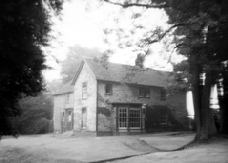|
The shutters which were taken down
from the windows of the old kitchen a few years ago were metal
lined and served for defence against attack.
About 20 years ago the house was struck by lightning,
resulting in an old beam being split and the house subsiding on
one side by about 2½ inches. In 1956 the death watch beetle was
discovered in the old roof beams, it was then that the split beam
was found. An old well was discovered under the scullery floor
when repairs were being done. The bricks round the top of the well
are obviously several hundred years old. Quantities of flints,
tiles etc. have been found dating back to Roman times. When
excavating last year workmen found an old coin of the reign of
James I.
Electricity was installed in the house in 1952 when
it was first brought to Ridley.
In the Ridley Church Register of Baptisms 1749-1812
may be seen the following entries:-
The Cedar and the Deodara in the Parsonage |
|
Meadow were planted on May 2nd 1849 and
were the gift of the Revd. H.D. Phelps, Vicar of Birling (signed)
Thos. P. Phelps, Rector of Ridley. The Wellingtonia Gigantea was
planted on August 30th 1866 by Herbert Dampier Phelps R.N. The
Deodara below the School (see "Glebe House") was planted
in the year 1864 (signed) Thos. P. Phelps. Rector.
These three trees commemorated the births of the Rev.
Thomas Phelps’ three sons. His son Lancelot Ridley Phelps had a
distinguished career, becoming eventually Provost of Oriel
College, Oxford.
While the incumbent was resident in the Rectory a
long building in Rectory Meadow was used as a Parish Room and all
Parish meetings were held there, including Sunday School. When the
Reverend H.B. Hennell moved to Ash Rectory and the Ridley Rectory
was let, Hodsoll Street and New Street were without a Parish
meeting place, and of course Ridley. |


